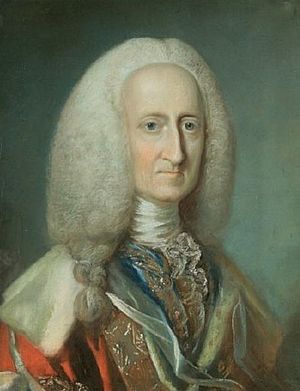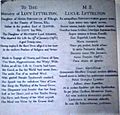George Lyttelton, 1st Baron Lyttelton facts for kids
Quick facts for kids
The Lord Lyttelton
|
|
|---|---|
 |
|
| Chancellor of the Exchequer | |
| In office 25 November 1755 – 16 November 1756 |
|
| Monarch | George II |
| Prime Minister | The Duke of Newcastle |
| Preceded by | Henry Bilson-Legge |
| Succeeded by | Henry Bilson-Legge |
| Personal details | |
| Born | 17 January 1709 Hagley, Worcestershire |
| Died | 22 August 1773 (aged 64) Hagley, Worcestershire |
| Nationality | British |
| Political party | Whig |
| Spouses |
Lucy Fortescue
(m. 1742; died 1747)Elizabeth Rich
(m. 1749) |
| Alma mater | Christ Church, Oxford |
George Lyttelton, 1st Baron Lyttelton (born January 17, 1709 – died August 22, 1773) was an important British statesman. He was also known as Sir George Lyttelton, 5th Baronet between 1751 and 1756.
Lyttelton was a writer himself. He also supported other writers and artists. He helped develop 18th-century landscape design, which means planning beautiful gardens and outdoor spaces.
Contents
Life of George Lyttelton
George Lyttelton was the oldest son of Sir Thomas Lyttelton, 4th Baronet. His mother was Christian, daughter of Sir Richard Temple. He went to Eton and Christ Church, Oxford for his education.
After college, he went on a "Grand Tour" of Europe. This was a long trip that young wealthy men took to learn about art and culture. During this time, he started writing and publishing poems and stories.
He continued to publish his writings even after becoming a Member of Parliament in 1735. In 1742, he married Lucy Fortescue. After she passed away in 1747, he married Elizabeth Rich in 1749.
Lord Lyttelton died in August 1773, when he was 64 years old. His oldest son, Thomas, became the next baron.
Political Career
Lyttelton was a Member of Parliament (MP) for Okehampton from 1735 to 1756. He was part of a group called "Cobham's Cubs" who opposed the Prime Minister, Robert Walpole.
From 1737, he worked as a secretary for Frederick, Prince of Wales. After Walpole lost power, Lyttelton became a Commissioner of the Treasury in 1744. In the same year, he became a Fellow of the Royal Society, which is a group for important scientists.
Lyttelton became a Privy Councillor in 1754. This is a special advisor to the King or Queen. The next year, he briefly became Chancellor of the Exchequer. This role is like the head of the country's money department. However, he did not do very well in this job.
In 1756, he was given the title of Lord Lyttelton, Baron of Frankley. This meant he became a "peer" and could speak in the House of Lords. He continued to speak there until a year before he died.
People later described Lyttelton as a kind and honest man. He was very religious and had good ideas. However, he was not seen as a very strong politician in practice.
Poetry and Support for Writers
Lord Lyttelton was a good friend and supporter of many famous writers. He was friends with Alexander Pope in the 1730s. He also supported Henry Fielding in the 1750s. Fielding even dedicated his famous novel Tom Jones to Lyttelton.
Lyttelton wrote a poem called "Epistle to Mr. Pope" when he was on his Grand Tour. In this poem, he suggested that Pope should write about patriotic themes. This poem was later used as an introduction to Pope's own works.
He helped many poets throughout his life. He arranged a pension (regular payment) for James Thomson. Thomson often visited Lyttelton's home, Hagley Hall. Lyttelton also helped Joseph Warton and David Mallet get important jobs.
Lyttelton's own poems were included in a famous collection of English poets. His poem "To the Memory of a Lady lately Deceased" was especially well-known. He wrote it after his first wife died. People praised this poem for being very touching and sad.
Besides poetry, Lyttelton also wrote many prose works. These were mostly about history and religion. Two of his works were known for their humor.
Letters from a Persian in England (1735) was a funny book. It showed the strange habits of English people through the eyes of a visitor from Persia. For example, the visitor wondered why marriage was a religious ceremony, which he thought was why people didn't take it seriously. Other writers, like Oliver Goldsmith, later used a similar idea.
Another humorous work was Lyttelton's Dialogues of the Dead (1760). In this book, famous people from history and literature have conversations after they have died. The conversations cover politics, literature, and philosophy. Sometimes the characters talk about unexpected things. For example, Joseph Addison and Jonathan Swift discuss politics.
Lyttelton encouraged bluestocking leader Elizabeth Montagu to write three of the dialogues in his book. All of Lyttelton’s writings were collected after his death by his nephew, G. E. Ayscough. Some of his works were also translated into French and German.
Hagley Hall and Grounds
Lyttelton spent many years and a lot of money developing Hagley Hall and its park. The park had many "follies". These are buildings that look like ruins or temples, built just for decoration.
The park also had memorials to famous poets like Milton, Pope, and Thomson. Lyttelton even built a "druid's temple" of standing stones on nearby Clent Hill. This was a memorial to a legendary poet named Ossian.
Sanderson Miller designed Hagley Hall itself. It is one of the last large Neo-Palladian style houses built in England. This style was popular in the 18th century and was based on ancient Roman and Greek buildings.
Images for kids
See also
 In Spanish: George Lyttelton para niños
In Spanish: George Lyttelton para niños





